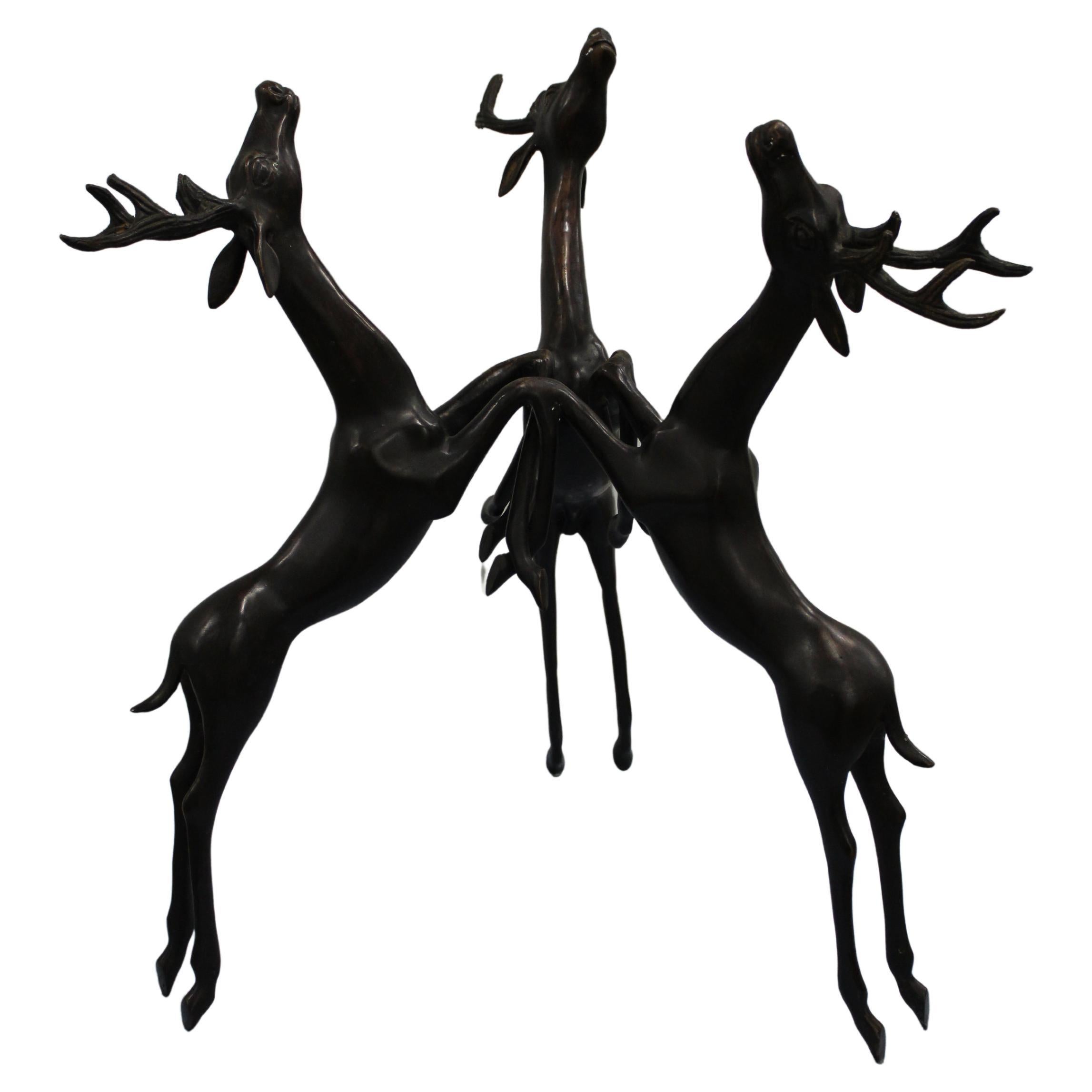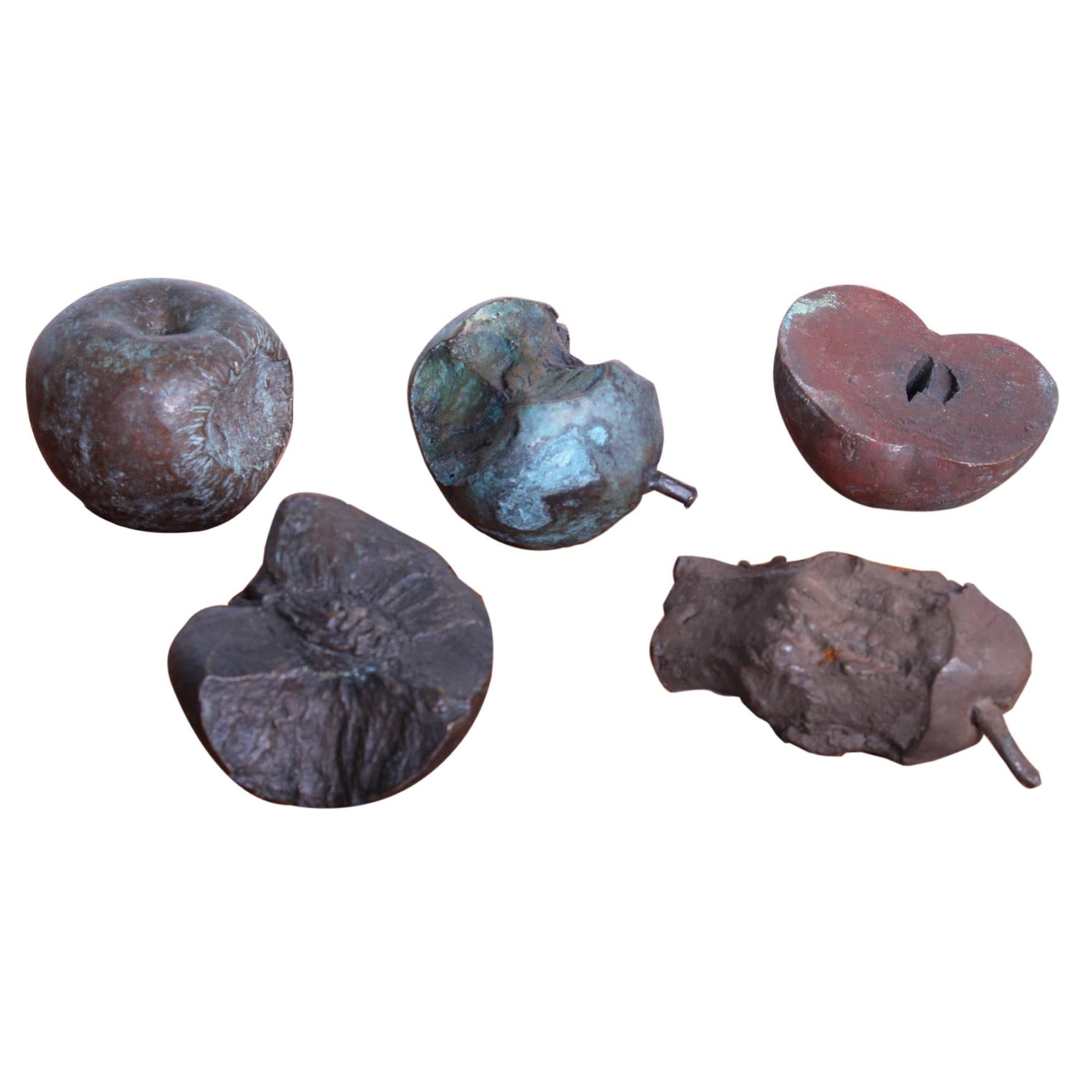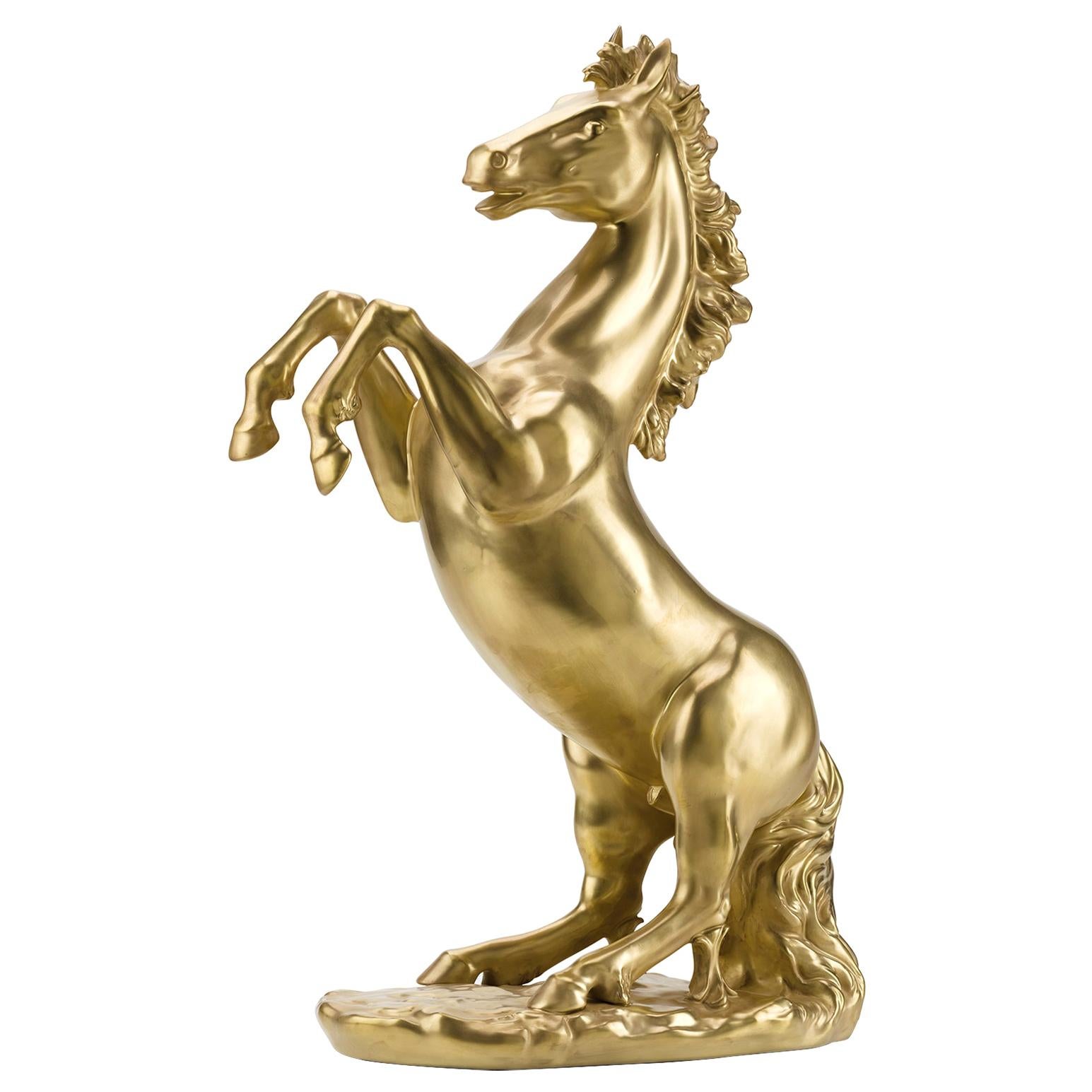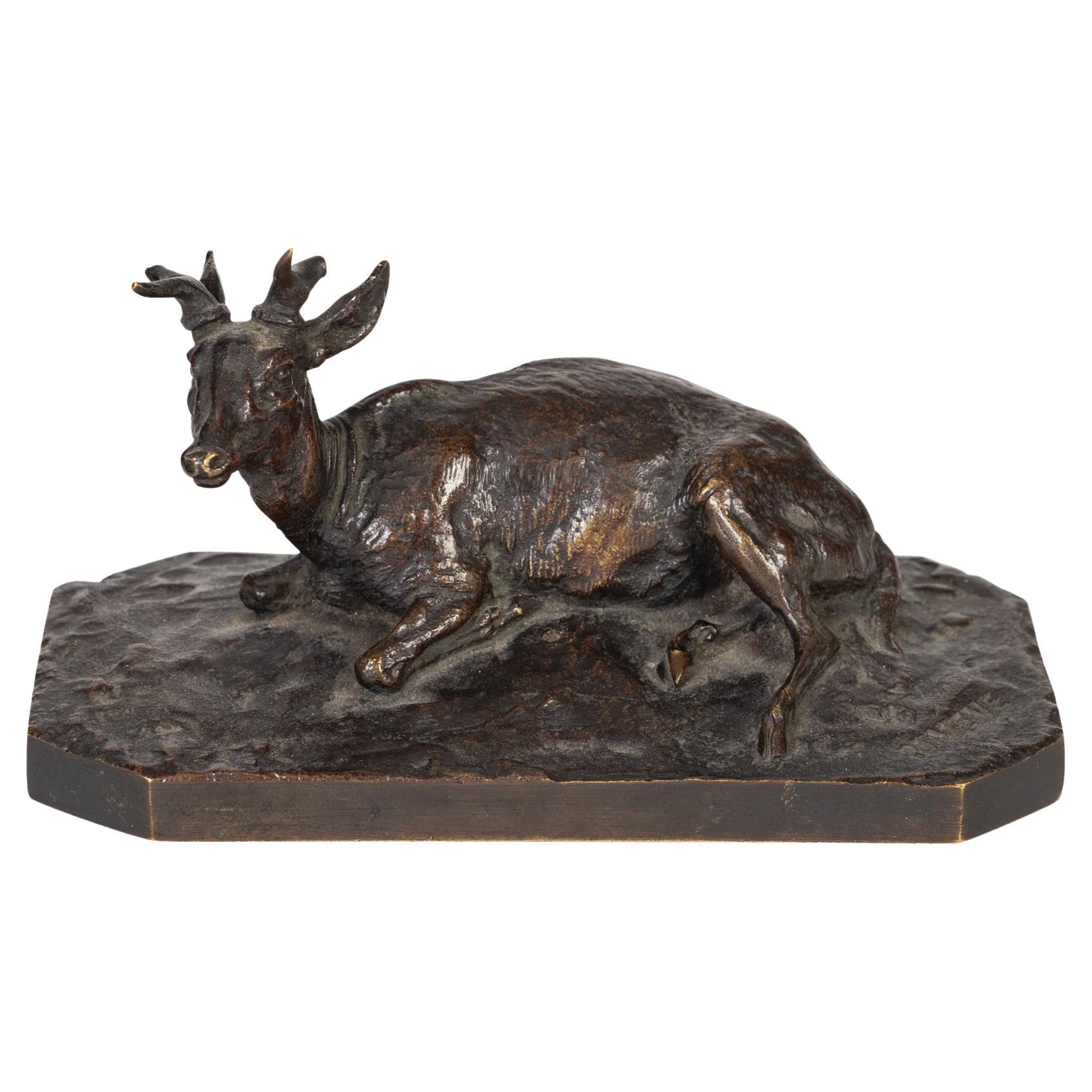Items Similar to A Small Bronze Group of a Prancing Stag
Want more images or videos?
Request additional images or videos from the seller
1 of 8
A Small Bronze Group of a Prancing Stag
About the Item
A Small Bronze Group of a Prancing Stag
Bronze, gilt bronze
South Germany; Nuremberg or Augsburg
Late 17th Century / Circa 1620
SIZE: 12cm high - 4¾ ins high
This bronze group, made in southern Germany, bears great similarities with the gilded silver table ornaments and mechanical automaton groups favoured by the princely courts of Germany, Austria and Northern Italy in the late 16th and early 17th centuries
Provenance:
Ex Private London collection, 1960’s
Ex Private collection through descent
LITERATURE:
K. Pechstein, ‘Nürnberger Brunnenfiguren der Renaissance’, Hambourg and Berlin, 1969, p. 27
- Dimensions:Height: 4.75 in (12.07 cm)Width: 3 in (7.62 cm)Depth: 1.2 in (3.05 cm)
- Materials and Techniques:
- Place of Origin:
- Period:
- Date of Manufacture:Circa 1620
- Condition:Wear consistent with age and use.
- Seller Location:London, GB
- Reference Number:1stDibs: LU9363239432002
About the Seller
No Reviews Yet
Vetted Seller
These experienced sellers undergo a comprehensive evaluation by our team of in-house experts.
Established in 1989
1stDibs seller since 2023
- ShippingRetrieving quote...Ships From: London, United Kingdom
- Return PolicyA return for this item may be initiated within 14 days of delivery.
More From This SellerView All
- A Polychrome and Parcel-Gilt Marble Group of the Virgin and ChildLocated in London, GBA Polychrome and Parcel-Gilt Marble Group of the Virgin and Child Attributed to Giovanni Di Balduccio (1317 - 1349) Marble Italy Circa 1330 - 1340 SIZE: 65cm high, 28cm wide - 25½ i...Category
Antique 15th Century and Earlier Italian Figurative Sculptures
MaterialsMarble
- A Superb Pair of Neapolitan Carved Figures of DwarvesBy Francesco CelebranoLocated in London, GBA Superb Pair of Neapolitan Carved Figures of Dwarves Attributed to Francesco Celebrano (1729 - 1814) Marble Naples, Italy 18th Century SIZE: Male: 36cm high - 14¼ ins high Fe...Category
Antique Late 18th Century Italian Figurative Sculptures
MaterialsMarble
- A Very Rare and Important Marble Relief of the ‘Resurrection of Christ’Located in London, GBA Very Rare and Important Marble Relief of the ‘Resurrection of Christ’ Attributed to the Master of the Mascoli Altar Marble Venice, Italy Second half of the 15th Century SIZE: ...Category
Antique 15th Century and Earlier Italian Renaissance Figurative Sculptures
MaterialsMarble
- A Fine Flemish Carved Figure of a ManLocated in London, GBA Fine Flemish Carved Figure of a Man Attributed to Henrick Douverman (c. 1480 - 1543) (sometimes known as Heinrich Douwermann) Wood (oak) Flemish Early 16th Century SIZE: 28cm high...Category
Antique 16th Century Dutch Figurative Sculptures
MaterialsWood
- A Wedgwood Black Basalt Library Bust of CiceroBy WedgwoodLocated in London, GBA Wedgwood Black Basalt Library Bust of Cicero (106–43 BC) Roman Orator and Statesman Impressed ‘Wedgwood’ and ‘Cicero’ to the reverse England Circa 1780 – 1795 Size: 29cm high - ...Category
Antique Late 18th Century British Busts
MaterialsTerracotta
- European Carved Limestone Celtic Votive Head of a Male WarriorLocated in London, GBA Large European Carved Limestone Celtic Votive Head of a Male Warrior Wearing a Typical Flowing Moustache Small Beard and Curling Locks of Hair Stiffened with Lime Wash the Slit Mouth Open as if in Command Circa 1st Century BC - 1st Century AD Size: 31cm high, 22cm wide, 25cm deep - 12¼ ins high, 8¾ ins wide, 9¾ ins deep / 42cm high - 16½ ins high (with base) From about 500 BC, first Greek and later Roman historians mention peoples living in a large area of non-mediterranean Europe as Celts. These classical chroniclers seem to have recognised these communities as having sufficient shared cultural traditions to justify their being given a common name, ‘Keltoi’ by the Greeks, and ‘Celtae’ or ‘Galli’ by the Romans. The earliest allusions to Celts by such Greek historians as Herodotus (485 - 425 BC) were followed by Polybius (200 - 118 BC) and Livy (59 BC - AD 17) who discuss the expansion of the Celts from their central European homelands during the 4th and 3rd centuries BC. They document the presence of Celts in Spain, France, Italy, Greece and Asia Minor, specifically central Turkey. They testify to the successful Roman resistance to the Celts in Italy, after the ignominy of the sacking of Rome by them in 387 BC, and describe the huge defeat suffered by the Celts at the battle of Telemon in northern Italy in 225 BC. The Celts in Greece who sacked the sacred site of Delphi in 279 BC were defeated by King Antigonos Gonatas of Macedon in 278 - 277 BC and in Turkey by Altalus of Pergamon in 240 BC. The Celts in Spain fell under the shadow of Rome from 2nd Century BC and the Celtic heartland known by the Romans as ‘Gaul’ was conquered by the Romans under Julius Caesar in the mid 1st Century BC. Britain was not referred to as Celtic by the ancient historians, but Caesar recognised the close similarities between Britain and Gaul especially in their political organisation. Tacitus (55 - 120 AD) and others chronicled the conquest of Britain between 43 and 84 AD some mentioning the fierce nature of the Celts who went into battle naked. Celtic art therefore belongs to an artistic tradition in the early history of Europe which is no less important than that of the classical world. Art was central to Celtic identity and was closely related to the objects which it decorated. The Celts were used to seeing art as an integral part of their everyday lives. Provenance: Ex Finch and Co...Category
Antique 15th Century and Earlier European Busts
MaterialsLimestone
You May Also Like
- Bronze Stag SculptureLocated in San Francisco, CAC. 20th century Amazing bronze stag sculpture.Category
20th Century Animal Sculptures
MaterialsBronze
- Group of Bronze FruitLocated in Dallas, TXA beautifully patinated group of five single casting bronze fruit.Category
Vintage 1970s Abstract Sculptures
MaterialsBronze
- Bronze Statue Pair of Deer, Stags RunningLocated in Stamford, CTA bronze statue of two deer running with their hind legs kicking up. This is a nice table top bronze of two stags running that would look great on a desk or coffee table. It does not...Category
Late 20th Century Thai Animal Sculptures
MaterialsBronze
- Bronze Group Sculpture Of GullsLocated in Guaynabo, PRThis is a Bronze Group Sculpture of Gulls. It depicts a large bronze sculpture of a group of gulls emigrating over the sea while another one is standing over some rocks. The sculptur...Category
20th Century Korean Modern Animal Sculptures
MaterialsBronze
- Prancing Stallion SculptureLocated in Paris, FRSculpture prancing stallion all made in porcelain and gold-plated in 24-karat.Category
21st Century and Contemporary Italian Animal Sculptures
MaterialsGold Plate
- Bronze Sculpture of Young Stag by Pierre-Jules MeneLocated in West Palm Beach, FLPierre-Jules MÈNE (1810-1879) French, A bronze sculpture of a young stag olive patina, finely cast and chiseled, signed in the cast PJ MENE, Dimensions: Width 4.80 in. (12.2 ...Category
Antique 19th Century Animal Sculptures
MaterialsBronze
Recently Viewed
View AllMore Ways To Browse
Bronze Gilt
Small Silver Animals
Great Northern
Antique Table Ornaments
Bear Ornament
Gilded Silver Table
German Antique Ornaments
Antique German Ornaments Ornaments
Antique German Ornaments
Mechanical Animal
Silver Table Ornament
Austrian Renaissance
Stag Sculpture
Southern Antiques
Bear Sculpture Silver
Mechanical Bronze
Circa 1620
17th Century Austrian





